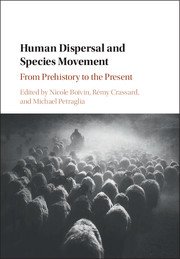Book contents
- Frontmatter
- Contents
- List of text boxes
- List of figures
- List of tables
- List of contributors
- Preface
- I Introduction
- II Origins: Species Movements in the Pleistocene
- III Across the water: Species movements by Coast and Sea
- IV Complexity: Species Movements in the Holocene
- 9 Dispersals, connectivity and indigeneity in Arabian prehistory
- 10 Reconstructing migration trajectories using ancient DNA
- 11 Out of the Fertile Crescent: The dispersal of domestic livestock through Europe and Africa
- 12 Adapting crops, landscapes, and food choices: Patterns in the dispersal of domesticated plants across Eurasia
- 13 Tracing the initial diffusion of maize in North America
- 14 Proto-globalisation and biotic exchange in the Old World
- V Invasion: The Movement of Invasive and Disease Species
- Index
- Plate section
- References
14 - Proto-globalisation and biotic exchange in the Old World
from IV - Complexity: Species Movements in the Holocene
Published online by Cambridge University Press: 04 May 2017
- Frontmatter
- Contents
- List of text boxes
- List of figures
- List of tables
- List of contributors
- Preface
- I Introduction
- II Origins: Species Movements in the Pleistocene
- III Across the water: Species movements by Coast and Sea
- IV Complexity: Species Movements in the Holocene
- 9 Dispersals, connectivity and indigeneity in Arabian prehistory
- 10 Reconstructing migration trajectories using ancient DNA
- 11 Out of the Fertile Crescent: The dispersal of domestic livestock through Europe and Africa
- 12 Adapting crops, landscapes, and food choices: Patterns in the dispersal of domesticated plants across Eurasia
- 13 Tracing the initial diffusion of maize in North America
- 14 Proto-globalisation and biotic exchange in the Old World
- V Invasion: The Movement of Invasive and Disease Species
- Index
- Plate section
- References
Summary
Abstract
While globalisation is often viewed as a contemporary transformation and symptom of the modern world, textual, archaeological, genetic, and other sources increasingly demonstrate significant interconnectivity – and linked biological exchange – in the ancient world. Already by the Bronze Age, major commercial networks existed in several parts of the Old World, leading to the human-mediated exchange of domesticated crops, animals, and other biological species. Trade links increased in the Iron Age, resulting in longer-distance commercial and biological exchanges. Species translocations in this period diversified subsistence but also resulted in the spread of deleterious species such as the black rat and the plague. Biological exchange further intensified in the Medieval period, with the emergence of expanded and intensified trade networks, particularly in the Indian Ocean. These brought a vast number of new breeds and species to societies across the Old World. Species moved for a whole variety of reasons, from the mundane to the symbolic, and were both intentionally and unintentionally transported by people. While introduced species are often vilified today, it is clear that the creation of increasingly cosmopolitan assemblages of organisms across the Old World not only at times transformed ecologies in negative ways, but also enriched diets, improved human health, made challenging landscapes habitable, and in many cases increased biodiversity.
Keywords: Biological exchange, invasive species, novel ecosystems, species translocation, Silk Road, trade, Indian Ocean
Globalisation tends to be seen as a contemporary phenomenon. Those of us alive today have the sense of living in a world that is undergoing profound change, as new technologies enable the collapse of age-old barriers to communication, travel, and economic integration. Linked to the globalisation of technology, ideas, culture, and commodities is a globalisation of the biological world, with intensive connectivity facilitating the spread of species beyond their native range. Like globalisation, the transfer of such ‘invasive’ species is seen as a recent phenomenon, a dangerous and costly corollary of a seemingly over-connected modern world. ‘Bioinvasions’ are described as ‘pathogens of globalization’ (Bright 1999), and scientists talk about the potential risk of invasive species as a feature of ‘bioterrorism’ and the need for ‘biosecurity’ (Meyerson and Reaser 2003).
But, in reality, the idea that either globalisation or invasive species are new is profoundly inaccurate. While the speed of communication and transport, and the degree of economic integration today may be greatly increased, we live in a world that has long been ‘globalising’.
- Type
- Chapter
- Information
- Human Dispersal and Species MovementFrom Prehistory to the Present, pp. 349 - 408Publisher: Cambridge University PressPrint publication year: 2017
References
- 9
- Cited by



